Built as a private residence, this building was converted into The Green Parrot in c1977. The old house stood in wooded grounds and was originally named Pentrig House, from the Cornish meaning ‘end of the sea’ or ‘low tide’. In the late 1890s and early 1900s, it was the home of Joseph Teague, ‘Capt. & Hon. Major’ in the 1st Volunteer Battalion, Duke of Cornwall’s Light Infantry, Perranporth.
Text about The Green Parrot.
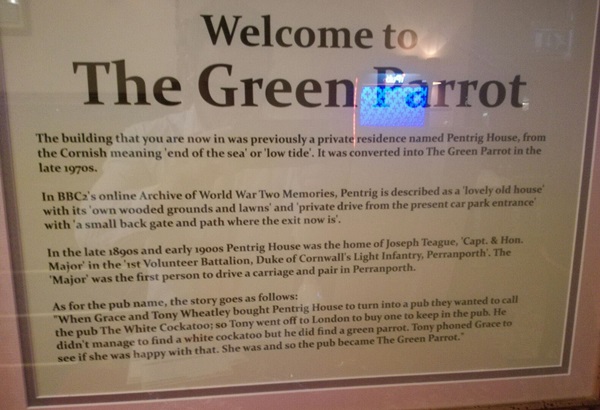
The text reads: The building that you are now in was previously a private residence name Pentrig House, from the Cornish meaning ’end of the sea’ or ‘low tide’. It was converted into The Green Parrot in the late 1970s.
In BBC2’s online Archive of The World War Two Memories, Pentrig is described as a “lovely old house” with its “own wooded grounds and lawns” and “private drive from the present car park entrance” with a “small black gate and path where the exit is now”.
In the late 1890s and early 1900s Pentrig House was the home of Joseph Teague, “Capt. & and Hon. Major” in the “1st Volunteer Battalion, Duke of Cornwall’s Light Infantry. Perranporth”. The ‘Major’ was the first person to drive a carriage and pair in Perranporth.
As for the pub name, the story goes as follows:
“When Grace and Tony Wheatley bought Pentrig House to turn into a pub they wanted to call the pub The White Cockatoo; so Tony went off to London to buy one to keep in the pub. He didn’t manage to find a white cockatoo but he did find a green parrot. Tony phoned Grace to see if she was happy with that. She was and so the pub became The Green Parrot”.
A photograph and text about Perranporth at war.
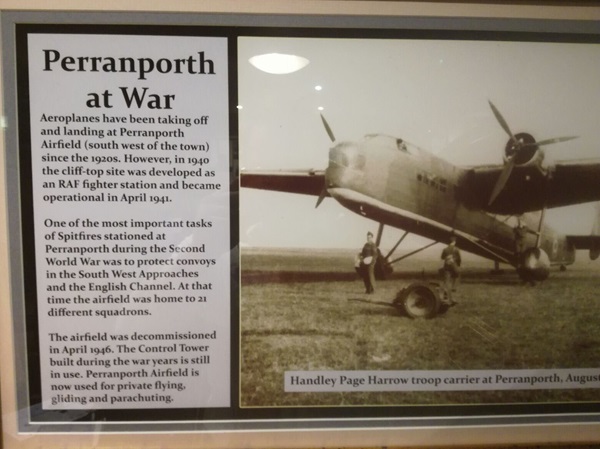
The text reads: Aeroplanes have been taking off and landing at Perranporth Airfield (south west of the town) since the 1920s. However, in 1940 the cliff-top site was developed as an RAF fighter station and became operational in April 1941.
One of the most important tasks of Spitfires stationed at Perranporth during the Second World War was to protect convoys in the South West Approaches and the South West Approaches and the English Channel. At the time the airfield was home to 21 different squadrons.
The airfield was decommissioned in April 1946. The control tower built during the war years is still in use. Perranporth Airfield is now used for private flying, gliding and parachuting.
Right: Handley Page Harrow troop carrier at Perranporth.
Text about the history of surfing.
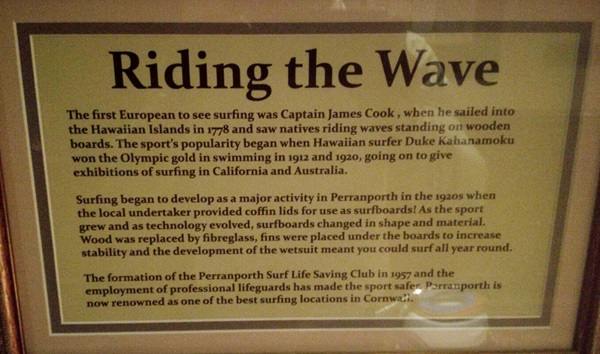
The text reads: The first European to see surfing was Captain James Cook, when he sailed into the Hawaiian Islands in 1778 and saw natives riding waves standing on wooden boards. The sport’s popularity began when Hawaiian surfer Duke Kahanamoku won the Olympic gold in swimming in 1912 and 1920, going on to give exhibitions of surfing in California and Australia.
Surfing began to develop as a major activity in Perranporth in the 1920s when the local undertaker provided coffin lids for use as surfboards! As the sport grew and as technology evolved, surfboards changed in shape and material. Wood was replaced by fibreglass, fins were placed under the boards to increase stability and the development of the wetsuit meant you could surf all year round.
The formation of the Perranporth Surf Life Saving Club in 1957 and the employment of professional lifeguards has made the sport safer. Perranporth is now renowned as one of best surfing locations in Cornwall.
Text about Winston Graham – the creator of Poldark.
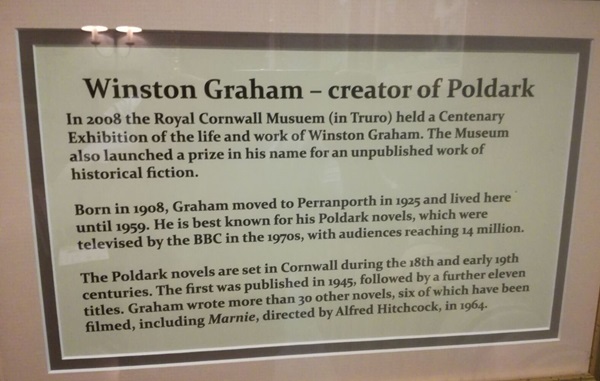
The text reads: In 2008 the Royal Cornwall Museum (in Truro) held a Centenary Exhibition of the life and work of Winston Graham. The Museum also launched a prize in his name for an unpublished work of historical fiction.
Born in 1908, Graham moved to Perranporth in 1925 and lived here until 1959. He is best known for his Poldark novels, which were televised by the BBC in the 1970s, with audiences reaching 14 million.
The Poldark novels are set in Cornwall during the 18th and early 19th centuries. The first published in 1945, followed by a further eleven titles. Graham wrote more than 30 other novels, six of which have been filmed, including Marnie, directed by Alfred Hitchcock in 1964.
Text about Alfred Bernhard Nobel – the pacifist who invented dynamite.
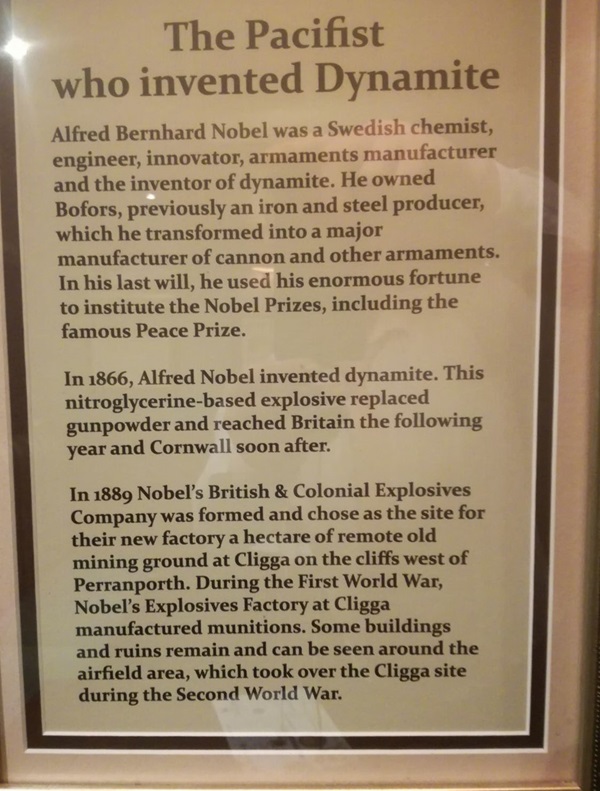
The text reads: Alfred Bernhard Nobel was a Swedish chemist, engineer, innovator, armaments manufacturer and the inventor of dynamite. He owned Bofors, previously an iron and steel producer, which he transformed into a major manufacturer of cannon and other armaments. In his last will, he used his enormous fortune to institute the Nobel Prizes, including the famous Peace Prize.
In 1866, Alfred Nobel invented dynamite. This nitroglycerine-based explosive replaced gunpowder and reached Britain the following year and Cornwall soon after.
In 1889 Nobel’s British & Colonial Explosives Company was formed and chose as the site for their new factory, a hectare of remote old mining ground at Cligga, on the cliffs west of Perranporth. During the First World War, Nobel’s Explosives Factory at Cligga manufactured munitions. Some buildings and ruins remain and can be seen around the airfield area, which took over the Cligga site during the Second World War.
Photographs and text about mines and miners.
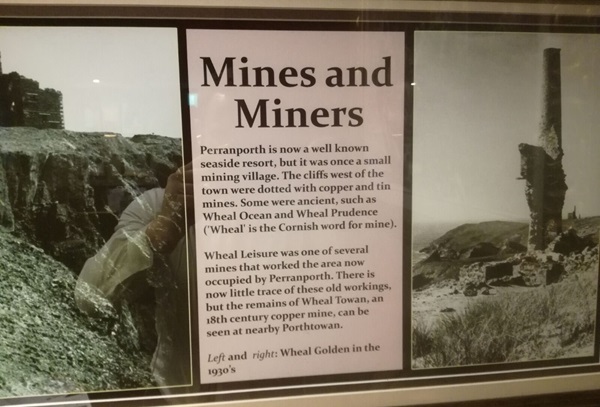
The texts read: Perranporth is now a well-known seaside resort, but it was once a small mining village. The cliffs west of the town were dotted with copper and tin mines. Some were ancient, such as Wheal Ocean and Wheal Prudence (‘Wheal’ is the Cornish word for mine).
Wheal Leisure was one of several mines that worked the area now occupied by Perranporth. There is now little trace of these old workings, but the remains of Wheal Towan, an 18th century copper mine, can be seen at nearby Porthtowan.
Left and right: Wheal Golden in the 1930s.
Text about rally car driver Donald Healey.
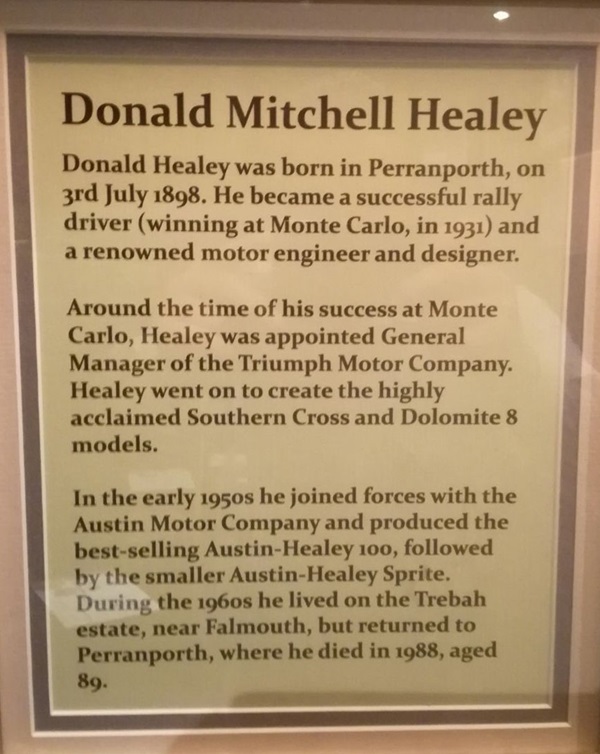
The text reads: Donald Healey was born in Perranporth, on 3 July 1898. He became a successful rally driver (winning at Monte Carlo, in 1931) and renowned motor engineer and designer.
Around the time of his success at Monte Carlo, Healey was appointed general manager of the Triumph Motor Company. Healey went to create the highly acclaimed Southern Cross and Dolomite 8 models.
In the early 1950s he joined forces with the Austin Motor Company and produced the best-selling Austin-Healey 100, followed by the smaller Austin-Healey Sprite. During the 1960s he lived on the Trebah estate, near Falmouth, but returned to Perranporth, where he died in 1988, aged 89.
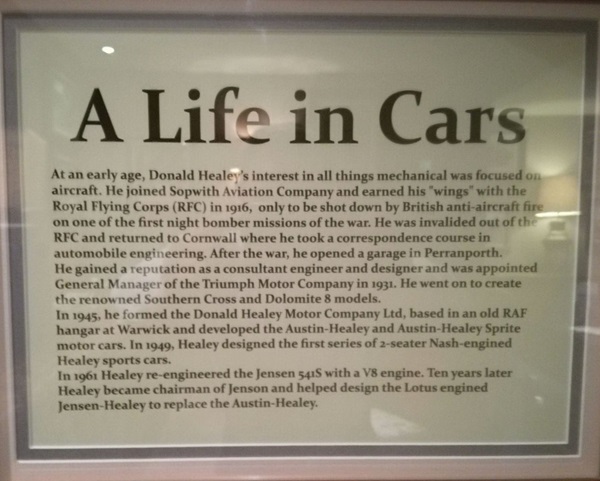
The text reads: At an early age, Donald Healey’s interest in all things mechanical was focused on aircraft. He joined Sopwith Aviation Company and earned his ‘wings’ with the Royal Flying Corps (RFC) in 1916, only to be shot down by British anti-aircraft fire on one of the first night bomber missions of the war. He was invalided out of the RFC and returned to Cornwall where he took a correspondence course in automobile engineering. After the war, he opened a garage in Perranporth. He gained a reputation as a consultant engineer and designer and was appointed general manager of the Triumph Motor Company in 1931. He went on to create the renowned Southern Cross and Dolomite 8 models.
In 1945, he formed the Donald Healey Motor Company Ltd, based in an old RAF hanger at Warwick and developed the Austin-Healey and Austin-Healey Sprite motor cars. In 1949, Healey designed the first series of two seater Nash-engined Healey sport cars.
In 1961 Healey re-engineered the Jessen 541S with a V8 engine. Ten years later Healey because chairman of Jenson and helped design the Lotus engined Jenson-Healey to replace the Austin-Healey.
Text about The Perranporth Players.
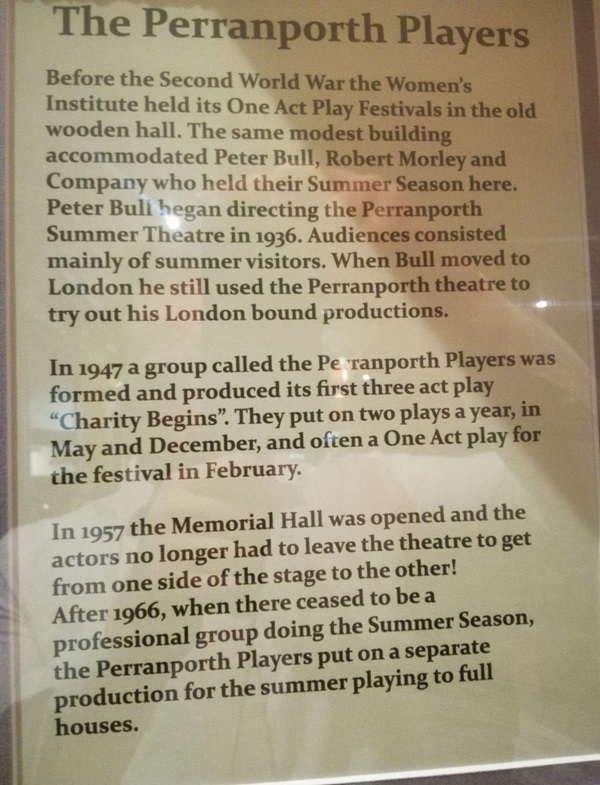
The text reads: Before the Second World War the Women’s Institute held its One Act Play Festivals in the old wooden hall. The same modest building accommodated Peter Bull, Robert Morley and company who held their summer season here. Peter Bull began directing the Perranporth Summer Theatre in 1936. Audiences consisted mainly of summer visitors. When Bull moved to London he still used the Perranporth Theatre to try out London bound productions.
In 1947 a group called the Perranporth Players was formed and produced its first three act play Charity Begins. They put on two plays a year, in May and December, often a one act play for the festival in February.
In 1957 the Memorial Hall was opened and the actors no longer had to leave the theatre to get from one side of the stage to the other! After 1966, when there ceased to be a professional group doing the summer season, the Perranporth Players put on a separate production for the summer playing to full houses.
A statue entitled The Green Parrot, by Thrussell and Thrussell.
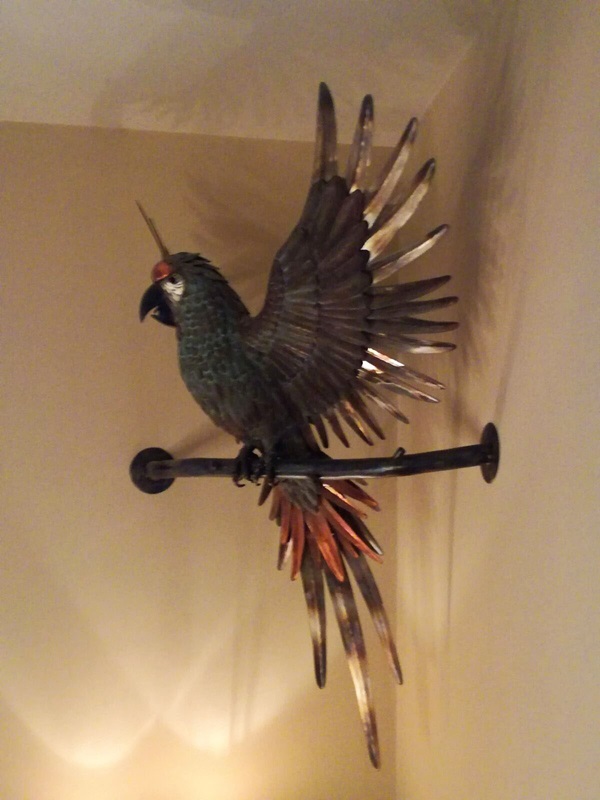
Gary Thrussell and Thomas Thrussell, father and son and artist metalsmiths, have their studio on Bodmin Moor. They specialise in natural history and community heritage artwork, working with communities to celebrate and commemorate the local heritage of area in metal sculpture.
An oil painting entitled Chapel Rock, Perranporth, by Tony Shorthouse.
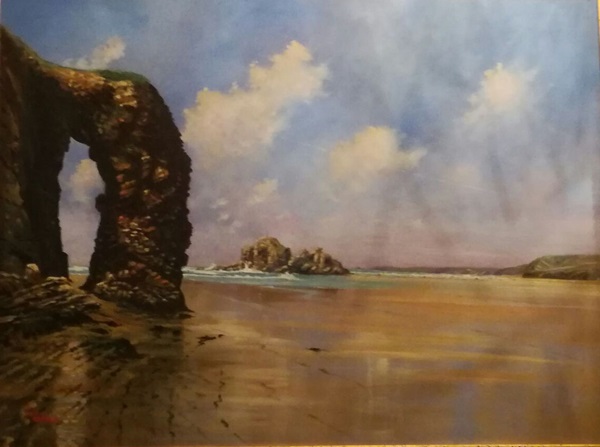
Tony Shorthouse is a local artist based in west Cornwall known for his representational work, mainly in oils, of the landscape and coastline of Cornwall and Brittany.
External photograph of the building – rear entrance.
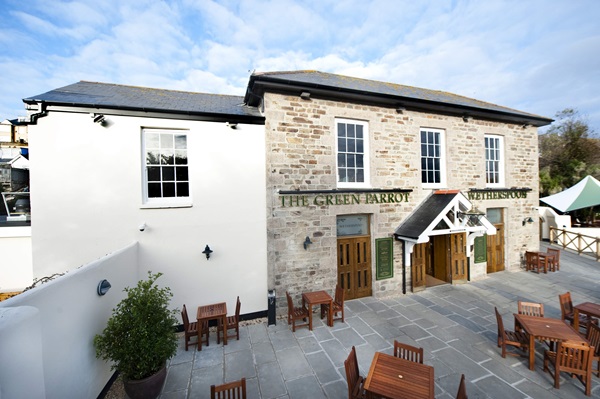
If you have information on the history of this pub, then we’d like you to share it with us. Please e-mail all information to: pubhistories@jdwetherspoon.co.uk